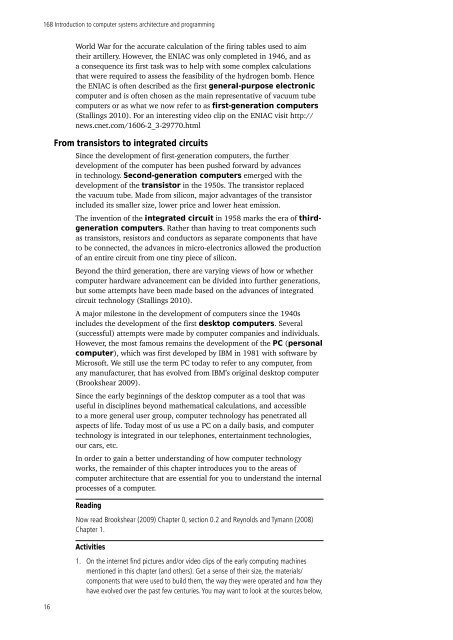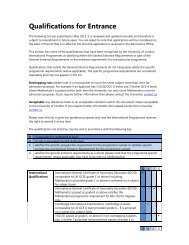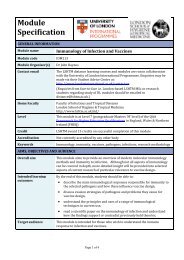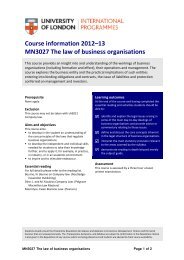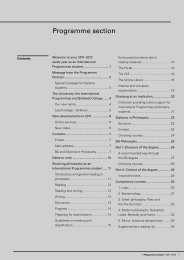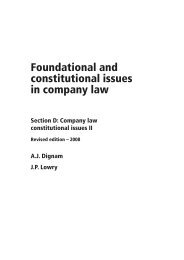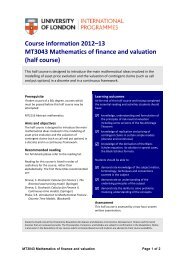Introduction to computer systems architecture and programming
Introduction to computer systems architecture and programming
Introduction to computer systems architecture and programming
You also want an ePaper? Increase the reach of your titles
YUMPU automatically turns print PDFs into web optimized ePapers that Google loves.
168 <strong>Introduction</strong> <strong>to</strong> <strong>computer</strong> <strong>systems</strong> <strong>architecture</strong> <strong>and</strong> <strong>programming</strong><br />
16<br />
World War for the accurate calculation of the firing tables used <strong>to</strong> aim<br />
their artillery. However, the ENIAC was only completed in 1946, <strong>and</strong> as<br />
a consequence its first task was <strong>to</strong> help with some complex calculations<br />
that were required <strong>to</strong> assess the feasibility of the hydrogen bomb. Hence<br />
the ENIAC is often described as the first general-purpose electronic<br />
<strong>computer</strong> <strong>and</strong> is often chosen as the main representative of vacuum tube<br />
<strong>computer</strong>s or as what we now refer <strong>to</strong> as first-generation <strong>computer</strong>s<br />
(Stallings 2010). For an interesting video clip on the ENIAC visit http://<br />
news.cnet.com/1606-2_3-29770.html<br />
From transis<strong>to</strong>rs <strong>to</strong> integrated circuits<br />
Since the development of first-generation <strong>computer</strong>s, the further<br />
development of the <strong>computer</strong> has been pushed forward by advances<br />
in technology. Second-generation <strong>computer</strong>s emerged with the<br />
development of the transis<strong>to</strong>r in the 1950s. The transis<strong>to</strong>r replaced<br />
the vacuum tube. Made from silicon, major advantages of the transis<strong>to</strong>r<br />
included its smaller size, lower price <strong>and</strong> lower heat emission.<br />
The invention of the integrated circuit in 1958 marks the era of thirdgeneration<br />
<strong>computer</strong>s. Rather than having <strong>to</strong> treat components such<br />
as transis<strong>to</strong>rs, resis<strong>to</strong>rs <strong>and</strong> conduc<strong>to</strong>rs as separate components that have<br />
<strong>to</strong> be connected, the advances in micro-electronics allowed the production<br />
of an entire circuit from one tiny piece of silicon.<br />
Beyond the third generation, there are varying views of how or whether<br />
<strong>computer</strong> hardware advancement can be divided in<strong>to</strong> further generations,<br />
but some attempts have been made based on the advances of integrated<br />
circuit technology (Stallings 2010).<br />
A major miles<strong>to</strong>ne in the development of <strong>computer</strong>s since the 1940s<br />
includes the development of the first desk<strong>to</strong>p <strong>computer</strong>s. Several<br />
(successful) attempts were made by <strong>computer</strong> companies <strong>and</strong> individuals.<br />
However, the most famous remains the development of the PC (personal<br />
<strong>computer</strong>), which was first developed by IBM in 1981 with software by<br />
Microsoft. We still use the term PC <strong>to</strong>day <strong>to</strong> refer <strong>to</strong> any <strong>computer</strong>, from<br />
any manufacturer, that has evolved from IBM’s original desk<strong>to</strong>p <strong>computer</strong><br />
(Brookshear 2009).<br />
Since the early beginnings of the desk<strong>to</strong>p <strong>computer</strong> as a <strong>to</strong>ol that was<br />
useful in disciplines beyond mathematical calculations, <strong>and</strong> accessible<br />
<strong>to</strong> a more general user group, <strong>computer</strong> technology has penetrated all<br />
aspects of life. Today most of us use a PC on a daily basis, <strong>and</strong> <strong>computer</strong><br />
technology is integrated in our telephones, entertainment technologies,<br />
our cars, etc.<br />
In order <strong>to</strong> gain a better underst<strong>and</strong>ing of how <strong>computer</strong> technology<br />
works, the remainder of this chapter introduces you <strong>to</strong> the areas of<br />
<strong>computer</strong> <strong>architecture</strong> that are essential for you <strong>to</strong> underst<strong>and</strong> the internal<br />
processes of a <strong>computer</strong>.<br />
Reading<br />
Now read Brookshear (2009) Chapter 0, section 0.2 <strong>and</strong> Reynolds <strong>and</strong> Tymann (2008)<br />
Chapter 1.<br />
Activities<br />
1. On the internet find pictures <strong>and</strong>/or video clips of the early computing machines<br />
mentioned in this chapter (<strong>and</strong> others). Get a sense of their size, the materials/<br />
components that were used <strong>to</strong> build them, the way they were operated <strong>and</strong> how they<br />
have evolved over the past few centuries. You may want <strong>to</strong> look at the sources below,


